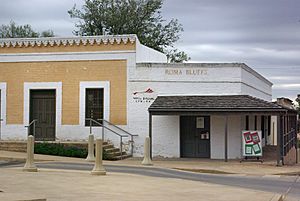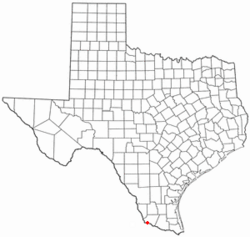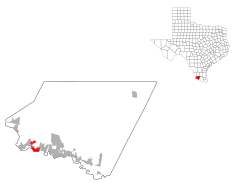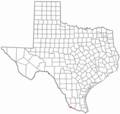Roma, Texas facts for kids
Quick facts for kids
Roma, Texas
|
|
|---|---|
 |
|

Location of Roma, Texas
|
|
 |
|
| Country | United States |
| State | Texas |
| County | Starr |
| Incorporated | 1936 |
| Government | |
| • Type | Council-Manager |
| Area | |
| • Total | 6.00 sq mi (15.55 km2) |
| • Land | 5.87 sq mi (15.19 km2) |
| • Water | 0.14 sq mi (0.36 km2) |
| Elevation | 213 ft (65 m) |
| Population
(2020)
|
|
| • Total | 11,561 |
| • Density | 1,959.08/sq mi (756.44/km2) |
| Time zone | UTC-6 (Central (CST)) |
| • Summer (DST) | UTC-5 (CDT) |
| ZIP code |
78584
|
| Area code(s) | 956 |
| FIPS code | 48-63020 |
| GNIS feature ID | 1388200 |
Roma is a city in Starr County, Texas, United States. In 2020, about 11,561 people lived there. The city is located along the Rio Grande river. It sits across from Ciudad Miguel Alemán in Tamaulipas, Mexico.
Roma is also known as Roma-Los Saenz. This is because the city includes the area once called Los Saenz. It acts as a port of entry between Mexico and the U.S. People can cross the border using the Roma–Ciudad Miguel Alemán International Bridge.
Contents
Exploring Roma: What to See
The center of Roma has many old and beautiful buildings. These buildings are now part of the Roma Historic District.
Birdwatching in Roma
Roma is a great place for birdwatching. Many different birds can be seen here. A part of the World Birding Center is located on Portsheller Street. It is right across from the city hall.
Views of the Rio Grande
The Rio Grande river is less than 200 feet wide at Roma. A high area next to the town square looks over the river. You can easily see parts of Ciudad Miguel Alemán from here. Because of these amazing views, this spot is often used by reporters and officials. They visit the area to show what the border region looks like.
A Look Back: Roma's History
Roma was founded in 1821. At that time, it was part of a Spanish province called Nuevo Santander.
Early Beginnings and Border Changes
Before Texas became independent from Mexico in 1836, Roma was under the control of Mier, Tamaulipas. Before Mexico became independent, the area was ruled by Spain.
The location was a good spot to cross the Rio Grande. It became known as El Paso de la Mula, meaning "Pass of the Mule." The area was also important for trading salt. Salt was moved from Roma to Monterrey.
When Mexico wrote its constitution in 1824, the Roma area became part of the Mexican state of Tamaulipas. Texas claimed Roma when the Republic of Texas was formed in 1835. However, Mexico still controlled this area. In 1842, a group from Texas tried to take Roma in the Mier Expedition. Many of these volunteers were killed or captured.
After the Mexican-American War
After the Mexican–American War in 1846, the U.S. gained control of the north side of the Rio Grande. Texas then began to govern Roma. During the American Civil War, the region became rich from trading cotton. Cotton was sent through Mexico to Europe.
Steamboats could reach Roma in the mid-1800s. But the river's water levels dropped because of new developments upstream. This stopped river shipping by the 1880s. Since railroads did not come to Roma, the town did not grow much. This helped preserve its old buildings.
Historic Buildings in Roma
The Roma National Historic Landmark District has more than 30 buildings built before 1900. Some of these important buildings include:
- The Customs House (Casa de Aduanas) was where people paid fees for goods brought in by steamboats.
- The John Vale/Noah Cox House was built in 1853. It has beautiful carved stone details.
- The Leocadia Garcia House, built in the 1840s, was first a home. Later, it became a store and a dance hall.
- Ramirez Hall is a two-story home. It was built by architect Heinrich Portscheller. This building was used as "Rosita's Cantina" in the 1950s movie Viva Zapata.
- The Manuel Guerra Building is considered the most beautiful restored building in Roma.
- The Néstor Saenz Store had direct access to the wharf. Steamboats used to dock there.
- The Edward Hord Office was built in 1853. During the Civil War, it was used as a military building.
- The Filomeno Gongora House was built around the 1830s. It is the oldest house in Roma.
- Our Lady of Refuge Church was built in 1853 by Father Pierre Yves Kéralum. He was a carpenter who became a priest.
- The Parish Hall was once a convent for nuns.
Where is Roma? Geography
Roma is located at 26°24′22″N 99°0′20″W / 26.40611°N 99.00556°W.
The city grew in size before the 2010 census. It now covers about 4.2 square miles (11.0 km2). A small part of this area, about 0.1 square mile (0.3 km2), is covered by water.
The City of Roma is situated along the Rio Grande. This river forms the border between the United States and Mexico.
Who Lives in Roma? Demographics
| Historical population | |||
|---|---|---|---|
| Census | Pop. | %± | |
| 1940 | 1,414 | — | |
| 1950 | 1,576 | 11.5% | |
| 1960 | 1,496 | −5.1% | |
| 1970 | 2,154 | 44.0% | |
| 1980 | 3,384 | 57.1% | |
| 1990 | 8,059 | 138.2% | |
| 2000 | 9,617 | 19.3% | |
| 2010 | 9,765 | 1.5% | |
| 2020 | 11,561 | 18.4% | |
| U.S. Decennial Census | |||
In 2020, there were 11,561 people living in Roma. There were 3,045 households and 2,394 families.
Learning in Roma: Education
The Roma Independent School District provides public education in Roma. Younger students attend Anna S. Canavan Elementary School for pre-kindergarten. For grades K-5, students go to Florence J. Scott Elementary or Roel and Celia Saenz Elementary School. A small area is also served by Ynes B. Elementary School.
Both of the district's middle schools, Roma Middle and Ramiro Barrera, serve students in grades 6-8. Most students attend Roma Middle. Students in grades 9-12 go to Roma High School.
Fun and Culture in Roma
Most people in Roma speak Spanish. The city has a very large Fourth of July celebration. This event shows how patriotic the community is. Roma also celebrates Mexican Independence Day and a December caminata (a walking event). The culture in Roma is often described as "Tejano," which is a mix of Texan and Mexican influences.
Famous People from Roma
- Hector Hugo Gonzalez: A nurse educator and the first Mexican-American registered nurse to get a Ph.D. in the U.S.
- Jovita González de Mireles (1904–1983): A folklorist, teacher, and writer from Texas.
- Mariachi Nuevo Santander: This is the mariachi group from Roma High School. They have won the Mariachi Vargas Extravaganza five times in a row since 2013. They also auditioned for America's Got Talent in season 12.
Images for kids
See also
 In Spanish: Roma (Texas) para niños
In Spanish: Roma (Texas) para niños




